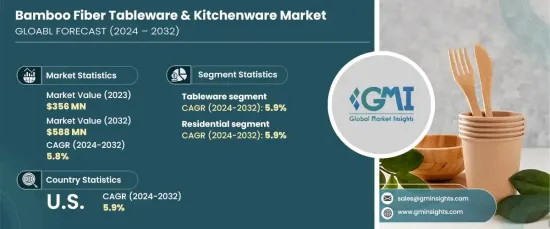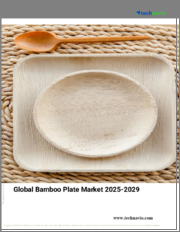
|
시장보고서
상품코드
1664841
세계의 대나무 섬유 식기 및 주방용품 시장 : 기회, 성장 촉진요인, 산업 동향 분석, 예측(2024-2032년)Bamboo Fiber Tableware and Kitchenware Market Opportunity, Growth Drivers, Industry Trend Analysis, and Forecast 2024 - 2032 |
||||||
세계의 대나무 섬유 식기 및 주방용품 시장은 2023년에 3억 5,600만 달러로 평가되었으며, 2024-2032년 동안 CAGR 5.8%를 나타낼 것으로 예측됩니다.
이러한 성장은 지속가능성이 세계 소비 동향의 중심을 차지하는 가운데, 환경 친화적이고 생분해성 제품에 대한 소비자 수요가 높아지고 있는 것이 배경에 있습니다. 대나무 섬유를 기반으로 한 식기와 주방용품은 플라스틱을 대체하는 환경 친화적인 대체품이며 일회용 플라스틱 사용량을 줄이는 세계의 노력과 일치합니다.

시장은 제품 유형별로 식기와 주방용품으로 구분됩니다. 2023년 식기 카테고리의 매출은 약 2억 300만 달러로, 2024-2032년의 CAGR은 약 5.9%로 확대될 것으로 예상되고 있습니다. 소비자와 기업은 지속 가능한 식탁 솔루션으로의 전환을 강화하고 있으며 대나무 섬유 식기 수요를 밀어 올리고 있습니다. 플라스틱 제품보다 재사용 가능한 생분해성 재료가 선호되는 경향은 보다 친환경적인 라이프스타일을 선택하려는 광범위한 움직임을 반영합니다.
| 시장 범위 | |
|---|---|
| 시작 연도 | 2023년 |
| 예측연도 | 2024-2032년 |
| 시작금액 | 3억 5,600만 달러 |
| 예측 금액 | 5억 8,800만 달러 |
| CAGR | 5.8% |
최종 용도의 관점에서 시장은 주거용 부문과 업무용 부문으로 나뉩니다. 주거용 부문은 2023년 전체 시장 점유율의 약 68%를 차지하며 예측 기간 동안 CAGR 5.9%로 성장할 것으로 예측됩니다. 도시의 가정에서는 미니멀리스트적이고 환경에 배려한 생활을 도입하는 경향이 강해지고 있어, 서스테이너블 대체 식기의 채용을 뒷받침하고 있습니다. BPA와 프탈산 에스테르와 같은 유해 물질이 없는 대나무 섬유 식기는 건강 지향 소비자와 무해한 선택을 요구하는 가족에게 특히 매력적입니다.
대나무 섬유 식기 및 주방용품의 미국 시장은 북미 중에서도 중요한 위치를 차지하고 있어 2023년의 매출은 약 7,500만 달러였습니다. 2024-2032년의 CAGR은 5.9%로 예측됩니다. 환경 문제에 대한 의식이 높아지고 지속 가능한 사례에 대한 노력이 증가함에 따라 미국은 친환경 제품의 주요 시장으로 자리매김하고 있습니다. 소비자는 기존 재료에서 대나무 섬유 대체품으로 적극적으로 전환하여 시장 성장을 더욱 촉진하고 있습니다.
목차
제1장 조사 방법과 조사 범위
- 시장 범위와 정의
- 기본 추정과 계산
- 예측 계산
- 데이터 소스
- 1차 데이터
- 2차 데이터
- 유료소스
- 공적 정보원
제2장 주요 요약
제3장 산업 인사이트
- 생태계 분석
- 밸류체인에 영향을 미치는 요인
- 이익률 분석
- 변혁
- 장래의 전망
- 제조업체
- 유통업체
- 공급자의 상황
- 이익률 분석
- 주요 뉴스 및 이니셔티브
- 규제 상황
- 영향요인
- 성장 촉진요인
- 환경 친화적인 생분해성으로 지속 가능한 제품에 대한 소비자 수요 증가
- 대나무 섬유의 식기나 주방용품을 구입하는 편리성과 입수의 용이성
- 산업의 잠재적 리스크 및 과제
- 높은 생산 비용
- 성장 촉진요인
- 성장 가능성 분석
- Porter's Five Forces 분석
- PESTEL 분석
제4장 경쟁 구도
- 소개
- 기업 점유율 분석
- 경쟁 포지셔닝 매트릭스
- 전략 전망 매트릭스
제5장 시장 추정·예측 : 제품 유형별, 2021-2032년
- 주요 동향
- 식기
- 평판
- 그릇
- 컵과 머그컵
- 트레이
- 기타(칼집 등)
- 주방용품
- 조리기구
- 보존 용기
- 도마
- 기타(그릇 등)
제6장 시장 추정·예측 : 용도별, 2021-2032년
- 주요 동향
- 주택용
- 업무용
- 호텔 및 레스토랑
- 카페
- 케이터링 서비스
- 기타(이벤트 서비스, 시설 이용 등)
제7장 시장 추정·예측 : 유통 채널별, 2021-2032년
- 주요 동향
- 온라인
- 오프라인
제8장 시장 추정·예측 : 지역별, 2021-2032년
- 주요 동향
- 북미
- 미국
- 캐나다
- 유럽
- 영국
- 독일
- 프랑스
- 이탈리아
- 스페인
- 러시아
- 아시아태평양
- 중국
- 인도
- 일본
- 한국
- 호주
- 라틴아메리카
- 브라질
- 멕시코
- 중동 및 아프리카
- 아랍에미리트(UAE)
- 사우디아라비아
- 남아프리카
제9장 기업 프로파일
- Bamboo Studio
- Bamboovement
- EcoSouLife
- Bambu Home
- Natural Home Brands
- Bamboo Biomass Products Ltd.
- Ecolife Innovations Ltd.
- ChopValue Manufacturing Ltd.
- Ekobo
- HUSK'SWARE
- Green Pioneer
- Better Earth Eco Products
- Arks Global
- Bamboo India
- Lysas Eco Products Co. Ltd.
The Global Bamboo Fiber Tableware And Kitchenware Market was valued at USD 356 million in 2023 and is projected to grow at a CAGR of 5.8% from 2024 to 2032. This growth is driven by increasing consumer demand for eco-friendly and biodegradable products, as sustainability takes center stage in global consumption trends. Bamboo fiber-based tableware and kitchenware offer an environmentally friendly alternative to plastic, aligning with worldwide efforts to reduce single-use plastic usage.

The market is segmented by product type into tableware and kitchenware. In 2023, the tableware category generated approximately USD 203 million in revenue and is expected to expand at a CAGR of around 5.9% from 2024 to 2032. Consumers and businesses are increasingly shifting toward sustainable dining solutions, boosting the demand for bamboo fiber tableware. The preference for reusable, biodegradable materials over plastic products underscores this trend, reflecting a broader movement towards greener lifestyle choices.
| Market Scope | |
|---|---|
| Start Year | 2023 |
| Forecast Year | 2024-2032 |
| Start Value | $356 Million |
| Forecast Value | $588 Million |
| CAGR | 5.8% |
In terms of end-use, the market is divided into residential and commercial segments. The residential segment accounted for approximately 68% of the total market share in 2023 and is anticipated to grow at a CAGR of 5.9% during the forecast period. Urban households are increasingly embracing minimalist, eco-conscious living, driving the adoption of sustainable dining alternatives. Bamboo fiber tableware, free of harmful substances like BPA and phthalates, has become particularly appealing to health-conscious consumers and families seeking non-toxic options.
The U.S. market for bamboo fiber tableware and kitchenware, a significant part of the North American region, contributed around USD 75 million in revenue in 2023. It is forecasted to grow at a CAGR of 5.9% from 2024 to 2032. Growing awareness of environmental issues and a rising commitment to sustainable practices have positioned the U.S. as a key market for eco-friendly products. Consumers are actively transitioning from traditional materials to bamboo fiber alternatives, further driving market growth.
Table of Contents
Chapter 1 Methodology & Scope
- 1.1 Market scope & definitions
- 1.2 Base estimates & calculations
- 1.3 Forecast calculations.
- 1.4 Data sources
- 1.4.1 Primary
- 1.4.2 Secondary
- 1.4.2.1 Paid sources
- 1.4.2.2 Public sources
Chapter 2 Executive Summary
- 2.1 Industry synopsis, 2021-2032
Chapter 3 Industry Insights
- 3.1 Industry ecosystem analysis
- 3.1.1 Factor affecting the value chain.
- 3.1.2 Profit margin analysis.
- 3.1.3 Disruptions
- 3.1.4 Future outlook
- 3.1.5 Manufacturers
- 3.1.6 Distributors
- 3.2 Supplier landscape
- 3.3 Profit margin analysis.
- 3.4 Key news & initiatives
- 3.5 Regulatory landscape
- 3.6 Impact forces
- 3.6.1 Growth drivers
- 3.6.1.1 Increasing consumer demand for eco-friendly, biodegradable, and sustainable products
- 3.6.1.2 The convenience and accessibility of purchasing bamboo fiber tableware and kitchenware
- 3.6.2 Industry pitfalls & challenges
- 3.6.2.1 High production costs
- 3.6.1 Growth drivers
- 3.7 Growth potential analysis
- 3.8 Porter’s analysis
- 3.9 PESTEL analysis
Chapter 4 Competitive Landscape, 2023
- 4.1 Introduction
- 4.2 Company market share analysis
- 4.3 Competitive positioning matrix
- 4.4 Strategic outlook matrix
Chapter 5 Market Estimates & Forecast, By Product Type, 2021-2032 (USD Million) (Million Units)
- 5.1 Key trends
- 5.2 Tableware
- 5.2.1 Plates
- 5.2.2 Bowls
- 5.2.3 Cups and mugs
- 5.2.4 Trays
- 5.2.5 Others (Cutlery, Etc)
- 5.3 Kitchenware
- 5.3.1 Cooking utensils
- 5.3.2 Storage containers
- 5.3.3 Cutting boards
- 5.3.4 Others (Mixing Bowls, Etc)
Chapter 6 Market Estimates & Forecast, By End-Use, 2021-2032 (USD Million) (Million Units)
- 6.1 Key trends
- 6.2 Residential
- 6.3 Commercial
- 6.4 Hotels & restaurants
- 6.5 Cafés
- 6.6 Catering services
- 6.7 Others (Event Services, Institutional Use, etc.)
Chapter 7 Market Estimates & Forecast, By Distribution Channel, 2021-2032 (USD Million) (Million Units)
- 7.1 Key trends
- 7.2 Online
- 7.3 Offline
Chapter 8 Market Estimates & Forecast, By Region, 2021-2032 (USD Million) (Million Units)
- 8.1 Key trends
- 8.2 North America
- 8.2.1 U.S.
- 8.2.2 Canada
- 8.3 Europe
- 8.3.1 UK
- 8.3.2 Germany
- 8.3.3 France
- 8.3.4 Italy
- 8.3.5 Spain
- 8.3.6 Russia
- 8.4 Asia Pacific
- 8.4.1 China
- 8.4.2 India
- 8.4.3 Japan
- 8.4.4 South Korea
- 8.4.5 Australia
- 8.5 Latin America
- 8.5.1 Brazil
- 8.5.2 Mexico
- 8.6 MEA
- 8.6.1 UAE
- 8.6.2 Saudi Arabia
- 8.6.3 South Africa
Chapter 9 Company Profiles
- 9.1 Bamboo Studio
- 9.2 Bamboovement
- 9.3 EcoSouLife
- 9.4 Bambu Home
- 9.5 Natural Home Brands
- 9.6 Bamboo Biomass Products Ltd.
- 9.7 Ecolife Innovations Ltd.
- 9.8 ChopValue Manufacturing Ltd.
- 9.9 Ekobo
- 9.10 HUSK’SWARE
- 9.11 Green Pioneer
- 9.12 Better Earth Eco Products
- 9.13 Arks Global
- 9.14 Bamboo India
- 9.15 Lysas Eco Products Co. Ltd.



















